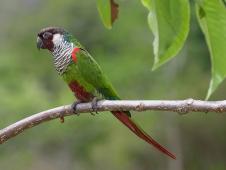
During the past 25 years under CITES and CMS, governments have agreed to take special conservation measures for an increasing number of bird species. However, many countries still allow exports of species without knowing whether this use of wild populations is sustainable. It is therefore important for range countries to review regularly the commercial trade in species listed under CITES Appendix II. Also, for many of the species listed under the CMS Appendices, inter-governmental Agreements and action plans have not yet been planned or concluded.

The Convention on International Trade in Endangered Species (CITES) and the Convention on Migratory Species (CMS) both incorporate lists of relevant species (as Appendices) for which particular conservation actions need to be implemented by contracting parties. For both CITES and CMS, Appendix I species are agreed to be of global conservation concern, with governments agreeing to prohibit all international commercial trade in wild birds of such species listed under CITES and to adopt strict protection measures for those listed under CMS. Appendix II species are agreed to have an unfavourable conservation status (CMS) or otherwise to benefit significantly from international co-operation in controlling their international trade (CITES) or in their conservation (CMS). Hence, governments are obliged to regulate and manage the import/export of Appendix II species listed under CITES, and to conclude agreements with other range states to conserve Appendix II species listed under CMS.
In an effort to protect groups vulnerable to over-harvesting, such as parrots and raptors, the number of bird species included in CITES Appendix II increased considerably up to the mid-1980s (see figure). However, many countries still allow exports of species without knowing whether this use of wild populations is sustainable. It is therefore important for range countries to review regularly the commercial trade in species listed in Appendix II and in some cases, prohibit the international trade through national export bans or by moving species to Appendix I.
As with CITES, the biggest changes in the CMS species-lists have taken place in Appendix II (see figure). A number of international Agreements have been adopted under CMS for its Appendix II bird species. For example, the listing of waterfowl in 1979 led eventually to the Agreement on the Conservation of African-Eurasian Migratory Waterbirds (AEWA) in 1995, which entered into force in 1999. The listing of albatrosses in Appendix II in 1997 enabled the subsequent adoption of the Agreement on the Conservation of Albatrosses and Petrels (ACAP), which entered into force in 2004. However, for many of the species listed in the CMS Appendices, inter-governmental Agreements and action plans have not yet been planned or concluded.
Compiled: 2004 Last updated: 2008
Recommended Citation:
BirdLife International (2008)
Species lists form a key part of several conventions and need to be reviewed and updated regularly.
Downloaded from https://datazone.birdlife.org/sowb/casestudy/species-lists-form-a-key-part-of-several-conventions-and-need-to-be-reviewed-and-updated-regularly on 22/12/2024